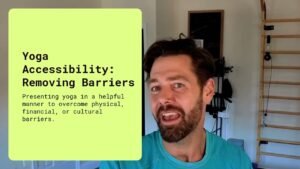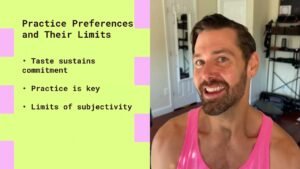Video: Ashtanga Vinyasa Inspired Flow
75 Minutes
6:12:12:6 grower pranayama
Touch & Go Standing
Intermediate A
Advanced A
Primary Marichi
Maitri Meditation
75 Minutes
6:12:12:6 grower pranayama
Touch & Go Standing
Intermediate A
Advanced A
Primary Marichi
Maitri Meditation

In this video, we unbox the concept of decolonizing your yoga practice by removing authoritarianism and emphasizing self-study. This episode covers the cultural context of Ashtanga Yoga, the impact of colonialism and capitalism in shaping Western yoga practices, and the need for open-source teaching. Michael discusses historical gender biases, the guru-student power dynamic, and the issues of gatekeeping and groupthink in yoga communities. Learn about the importance of making yoga accessible and fostering community-centered approaches while balancing tradition with the evolution of Ashtanga Yoga. Discover how decommodification and recognizing inner intelligence can lead to true liberation in your practice.
00:00 Dismantling Authoritarianism with Ashtanga Yoga: Power, Practice, Justice
00:01 Introduction to Decolonizing Yoga
00:15 Historical Context and Cultural Impact
01:12 Examining Patriarchal Elements
02:14 Power Dynamics and Gatekeeping
03:37 Cultural Imperialism in Teaching
04:50 Appropriation vs. Appreciation
06:43 Open Source Teaching as Solution
08:12 Making Yoga Accessible
10:12 Balancing Tradition with Evolution
11:49 Self-Education and Awareness
14:05 Conclusion: Path to Liberation

The Trap of Perfect Alignment in Yoga: Embrace Internal Balance
Michael Joel Hall discusses the pitfalls of obsessing over perfect alignment in yoga Asana. He emphasizes that the body is dynamic and that chasing an idealized form can lead to strain, frustration, and injury. Hall advocates for alignment that supports internal balance and sustainable practice rather than just external aesthetics. He reminds viewers that progress in Ashtanga Yoga is about stability, breath, and awareness, and that pain should be seen as a warning sign, not a marker of progress.
00:00 Introduction to Alignment in Yoga and Perfection’s Pitfalls
00:43 True Alignment: Internal Balance and Awareness

Individualized Sequencing in Ashtanga Yoga
—
**Introduction**
Hello! Michael Joel Hall here, diving into the world of individualized sequencing in Ashtanga Yoga. While Ashtanga is known as a structured system, it’s crucial to realize that adaptability is its core strength. Without it, the practice becomes fragile. The traditional sequence, developed throughout the late 20th century, is designed to cultivate strength, flexibility, and resilience through its progressive and intentional design. But what happens when the system faces the individual realities of injuries, physical limitations, and unique biomechanics?
—
**Understanding Challenges and Adaptations**
Ashtanga Yoga, like any practice, meets unique individual challenges. When faced with pain, limitations in breath stability, or when a posture aggravates an existing injury, adjustments become essential. It’s vital to adapt intelligently without compromising the essence of the practice. Obstacles such as existing injuries or unique physical structures can sometimes act as barriers that cannot be overcome by sheer determination or force.
—
**Integrating Therapeutic Adaptations and Vinyasa Flow**
Therapeutic adaptations can be integrated smoothly without breaking the vinyasa count, by maintaining the rhythm of breath and incorporating regressive movements that facilitate appropriate breathing and motion. The core purpose of Vinyasa is to preserve the continuous flow of energy. As long as substitutions support these core goals rather than disrupt them, why not embrace them? This way, the integrity of the system remains intact.
—
**Balancing Tradition with Sustainability**
One of the significant challenges in modern Ashtanga Yoga is balancing tradition with the sustainability of practice. As we incorporate our western conditions and lifestyles, rigid adherence can lead to more injuries or create unnecessary exclusion. There’s a misconception that modifying the practice will dismantle its structure, but that only happens if modifications are made without discernment. Understanding why the sequence exists and adapting it with respect and intelligence gives it a long-term vision.
For me, this practice extends beyond a single session. It’s an insight practice—a lifelong journey. Don’t you want a practice that offers lifetime insights?
—
In conclusion, individualized sequencing in Ashtanga Yoga is about making intelligent adaptations to honor both the tradition and personal needs. This nuance allows for sustainability and inclusivity, ensuring that the practice benefits each practitioner uniquely over their lifetime.

This is just a little bit about me, Michael Joel Hall. I posted this as part of my welcome letter at DC Ashtanga. Join the community at DCashtanga.com to take free courses on Decentralizing Ashtanga, built proudly in Washington, DC.

This episode is on the topic of subjectivity in Ashtanga Yoga. This video emphasizes the importance of internal experiences over external instructions, highlighting how true understanding comes from doing rather than merely discussing. Learn about the role of breath (pranayama), the significance of bandhas, and how individual taste and preference can shape your practice. Michael also touches on the balance between subjective experience and objective assessment, providing insights into refining your yoga journey for both nourishment and growth.
00:00 Introduction and Greeting
00:03 Understanding Subjectivity in Ashtanga Yoga
00:33 The Importance of Internal Experience
01:08 The Role of Bandhas and Breath
02:12 Developing Personal Practice
03:36 Balancing Subjectivity and Objectivity
04:03 Challenges in Self-Assessment
05:08 Community Influence and Objectivity
05:42 Conclusion and Final Thoughts

Michael Joel Hall offers a different approach to Ashtanga Yoga grounded in humanist values, personal agency, and inclusivity, rather than dogma or hierarchy. Inspired by Dr. Anastasia Somerville Wong’s work on non-religious pastoral support, Hall emphasizes creating a supportive community that encourages critical thinking, personal experience, and mutual care. Hall outlines signs of high-pressure, cult-like communities, such as suppression of critical thought, encouragement of self-doubt, prevalence of magical thinking, authoritarian leadership, non-accountability, excessive and intrusive rules, and financial and sexual exploitation. He contrasts these with healthy community traits like open discussion, personal autonomy, and ethical integrity. Hall’s philosophy aims to decentralize power, foster critical thinking, and honor each practitioner’s unique journey.
00:00 Introduction and Setup
01:44 Critical Thought in Healthy Groups
04:20 Encouraging Self-Esteem
05:42 Magical Thinking in Cults
07:26 Reason and Evidence-Based Approach
07:56 Charismatic Leaders and Special Knowledge
10:38 Authoritarian Leadership
11:46 Accountable vs. Authoritarian Leaders
13:11 Leaders Above the Law
14:25 Draconian and Intrusive Rules
17:08 Censorship and Control of Information
18:23 Elitism and Inner Circles
19:31 Threats to Those Who Leave
19:48 Financial and Physical Penalties
20:28 Respect vs. Shunning
21:33 Slander and Vilification of Outsiders
21:45 Us vs. Them Mentality in Yoga Communities
22:26 Spotting Negative Group Dynamics
23:13 Isolation from Outside Relationships
24:20 Group Identity vs. Individual Identity
26:05 Secrecy and Elitism in Groups
26:51 Negative Group Rituals and Punishment
27:23 Transparency vs. Secrecy
27:34 Mind-Altering Practices and Conformity
28:22 Managing Expectations and Consent
29:38 Shame, Guilt, and Fear in Group Control
30:31 Supportive vs. Controlling Environments
30:51 Obsessive Loyalty and Critical Thinking
32:30 Recruitment and Growth Obsession
33:55 Genuine Community vs. Aggressive Recruitment
34:55 Love Bombing and Idealistic Goals
36:42 Financial Exploitation in Groups
39:16 Punitive Punishment and Abuse
41:56 Sexual Exploitation in High-Pressure Groups
44:03 Gender Equality vs. Gender Control
45:29 Gossip and Community Safety
46:15 Normalization of Deception
46:40 Justifying Bad Behavior for Group’s Sake
47:03 Real Integrity and Ethical Standards
47:17 Values and Honesty in Tough Times
47:27 Maintaining High Ethical Standards